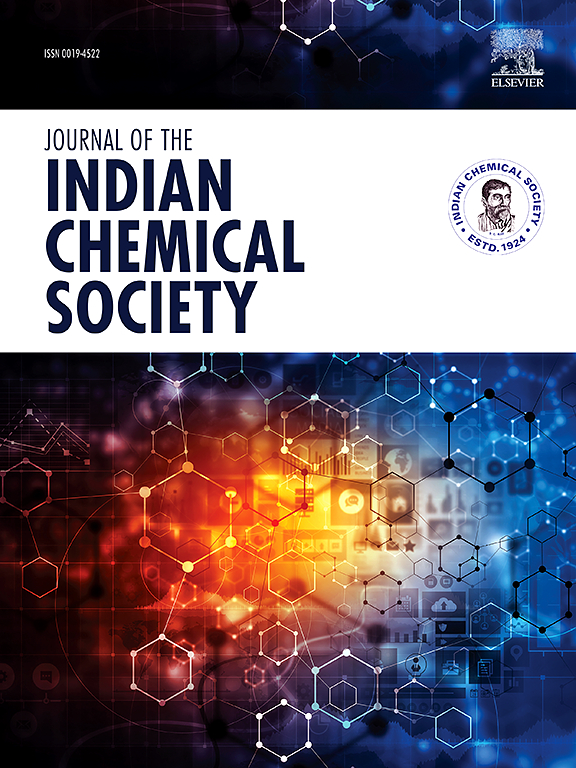Multifunctional Cu–TiO2 porous nano-structures via post-synthesis LASER treatment for boosting energy storage and photocatalytic applications
IF 3.2
4区 化学
Q2 CHEMISTRY, MULTIDISCIPLINARY
引用次数: 0
Abstract
In this work, copper-doped titanium dioxide (Cu–TiO2) porous nanostructures (CTPNs) are synthesized by a single-step Sol-gel technique followed by a post-synthesis LASER treatment and investigated their photocatalytic as well as electrochemical properties. The CTPNs exhibit a pure anatase phase, confirmed by X-ray diffraction (XRD), and their crystallite size has been drastically reduced from 38.43 to 16.38 nm. SEM analysis shows that pure TiO2 has irregular grains with interconnected pores, while the 0.5 % CTPNs sample features a highly porous, finely rough surface with bright spots, indicating Cu incorporation in the TiO2 matrix. The elemental composition of the synthesized CTPNs was confirmed through EDX spectroscopy. Furthermore, UV spectroscopy analysis indicated that with increasing Cu concentration in the TiO2, the optical band gap shrinks from 3.24 to 2.62 eV. The photocatalytic activity measurements showed that the addition of CTPNs increased methylene blue (MB) photodegradation by 35.7 % compared to 9.6 % for pure TiO2 as exposed to direct sunshine. Additionally, the electrochemical performance of the CTPNs-based electrodes for supercapacitors was validated through cyclic voltammetry. The 0.5 % CTPNs electrode demonstrated an enhanced specific capacitance of 279 F g−1, in contrast to the 17 F g−1 observed for pure TiO2. Furthermore, the 0.5 % CTPNs exhibited an impressive energy density of 24.67 W h Kg−1 at an operating voltage of 0–0.8 V for 1 M KOH. The exceptional performance of the CTPNs electrode has been justified by the incorporation of strong electrical conductivity of Cu, in the TiO2 lattice.

多功能Cu-TiO2多孔纳米结构合成后激光处理促进能量储存和光催化应用
在这项工作中,通过单步溶胶-凝胶技术和合成后激光处理合成了铜掺杂二氧化钛(Cu-TiO2)多孔纳米结构(CTPNs),并研究了它们的光催化和电化学性能。x射线衍射(XRD)证实,CTPNs为纯锐钛矿相,晶粒尺寸从38.43 nm大幅减小到16.38 nm。SEM分析表明,纯TiO2颗粒不规则,孔隙相互连接,而0.5% CTPNs样品多孔,表面精细粗糙,有亮点,表明Cu掺杂在TiO2基体中。合成的ctpn的元素组成通过EDX谱分析得到了证实。紫外光谱分析表明,随着TiO2中Cu浓度的增加,光学带隙从3.24 eV缩小到2.62 eV。光催化活性测试表明,CTPNs的加入使亚甲基蓝(MB)的光降解率提高了35.7%,而纯TiO2在阳光直射下的降解率为9.6%。此外,通过循环伏安法验证了基于ctpns的超级电容器电极的电化学性能。0.5% CTPNs电极的比电容为279 F g−1,而纯TiO2电极的比电容为17 F g−1。此外,在0-0.8 V、1 M KOH的工作电压下,0.5% ctpn的能量密度达到了24.67 W h Kg−1。通过在TiO2晶格中加入Cu的强导电性,证明了CTPNs电极的优异性能。
本文章由计算机程序翻译,如有差异,请以英文原文为准。
求助全文
约1分钟内获得全文
求助全文
来源期刊
CiteScore
3.50
自引率
7.70%
发文量
492
审稿时长
3-8 weeks
期刊介绍:
The Journal of the Indian Chemical Society publishes original, fundamental, theorical, experimental research work of highest quality in all areas of chemistry, biochemistry, medicinal chemistry, electrochemistry, agrochemistry, chemical engineering and technology, food chemistry, environmental chemistry, etc.

 求助内容:
求助内容: 应助结果提醒方式:
应助结果提醒方式:


